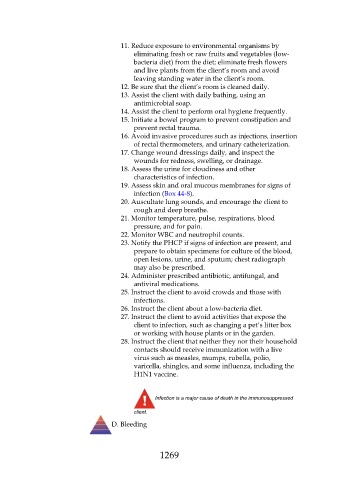Page 1269 - Saunders Comprehensive Review For NCLEX-RN
P. 1269
11. Reduce exposure to environmental organisms by
eliminating fresh or raw fruits and vegetables (low-
bacteria diet) from the diet; eliminate fresh flowers
and live plants from the client’s room and avoid
leaving standing water in the client’s room.
12. Be sure that the client’s room is cleaned daily.
13. Assist the client with daily bathing, using an
antimicrobial soap.
14. Assist the client to perform oral hygiene frequently.
15. Initiate a bowel program to prevent constipation and
prevent rectal trauma.
16. Avoid invasive procedures such as injections, insertion
of rectal thermometers, and urinary catheterization.
17. Change wound dressings daily, and inspect the
wounds for redness, swelling, or drainage.
18. Assess the urine for cloudiness and other
characteristics of infection.
19. Assess skin and oral mucous membranes for signs of
infection (Box 44-8).
20. Auscultate lung sounds, and encourage the client to
cough and deep breathe.
21. Monitor temperature, pulse, respirations, blood
pressure, and for pain.
22. Monitor WBC and neutrophil counts.
23. Notify the PHCP if signs of infection are present, and
prepare to obtain specimens for culture of the blood,
open lesions, urine, and sputum; chest radiograph
may also be prescribed.
24. Administer prescribed antibiotic, antifungal, and
antiviral medications.
25. Instruct the client to avoid crowds and those with
infections.
26. Instruct the client about a low-bacteria diet.
27. Instruct the client to avoid activities that expose the
client to infection, such as changing a pet’s litter box
or working with house plants or in the garden.
28. Instruct the client that neither they nor their household
contacts should receive immunization with a live
virus such as measles, mumps, rubella, polio,
varicella, shingles, and some influenza, including the
H1N1 vaccine.
Infection is a major cause of death in the immunosuppressed
client.
D. Bleeding
1269

